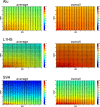Integrated Mobile Element Scanning (ME-Scan) method for identifying multiple types of polymorphic mobile element insertions
- PMID: 32110248
- PMCID: PMC7035633
- DOI: 10.1186/s13100-020-00207-x
Integrated Mobile Element Scanning (ME-Scan) method for identifying multiple types of polymorphic mobile element insertions
Abstract
Background: Mobile elements are ubiquitous components of mammalian genomes and constitute more than half of the human genome. Polymorphic mobile element insertions (pMEIs) are a major source of human genomic variation and are gaining research interest because of their involvement in gene expression regulation, genome integrity, and disease.
Results: Building on our previous Mobile Element Scanning (ME-Scan) protocols, we developed an integrated ME-Scan protocol to identify three major active families of human mobile elements, AluYb, L1HS, and SVA. This approach selectively amplifies insertion sites of currently active retrotransposons for Illumina sequencing. By pooling the libraries together, we can identify pMEIs from all three mobile element families in one sequencing run. To demonstrate the utility of the new ME-Scan protocol, we sequenced 12 human parent-offspring trios. Our results showed high sensitivity (> 90%) and accuracy (> 95%) of the protocol for identifying pMEIs in the human genome. In addition, we also tested the feasibility of identifying somatic insertions using the protocol.
Conclusions: The integrated ME-Scan protocol is a cost-effective way to identify novel pMEIs in the human genome. In addition, by developing the protocol to detect three mobile element families, we demonstrate the flexibility of the ME-Scan protocol. We present instructions for the library design, a sequencing protocol, and a computational pipeline for downstream analyses as a complete framework that will allow researchers to easily adapt the ME-Scan protocol to their own projects in other genomes.
Keywords: AluYb; High-throughput sequencing; LINE-1; ME-Scan; Mobile element insertion; Retrotransposon; SVA.
© The Author(s) 2020.
Conflict of interest statement
Competing interestsThe authors declare that they have no competing interests.
Figures



Similar articles
-
Identification of polymorphic SVA retrotransposons using a mobile element scanning method for SVA (ME-Scan-SVA).Mob DNA. 2016 Jul 30;7:15. doi: 10.1186/s13100-016-0072-x. eCollection 2016. Mob DNA. 2016. PMID: 27478512 Free PMC article.
-
Mobile element scanning (ME-Scan) by targeted high-throughput sequencing.BMC Genomics. 2010 Jun 30;11:410. doi: 10.1186/1471-2164-11-410. BMC Genomics. 2010. PMID: 20591181 Free PMC article.
-
Mobile element scanning (ME-Scan) identifies thousands of novel Alu insertions in diverse human populations.Genome Res. 2013 Jul;23(7):1170-81. doi: 10.1101/gr.148973.112. Epub 2013 Apr 18. Genome Res. 2013. PMID: 23599355 Free PMC article.
-
Emerging Opportunities to Study Mobile Element Insertions and Their Source Elements in an Expanding Universe of Sequenced Human Genomes.Genes (Basel). 2023 Oct 10;14(10):1923. doi: 10.3390/genes14101923. Genes (Basel). 2023. PMID: 37895272 Free PMC article. Review.
-
Mobile element biology: new possibilities with high-throughput sequencing.Trends Genet. 2013 May;29(5):280-9. doi: 10.1016/j.tig.2012.12.002. Epub 2013 Jan 9. Trends Genet. 2013. PMID: 23312846 Free PMC article. Review.
Cited by
-
SeqURE - a new copy-capture based method for sequencing of unknown Retroposition events.Mob DNA. 2020 Dec 14;11(1):33. doi: 10.1186/s13100-020-00228-6. Mob DNA. 2020. PMID: 33317630 Free PMC article.
-
The genetics of ductal adenocarcinoma of the pancreas in the year 2020: dramatic progress, but far to go.Mod Pathol. 2020 Dec;33(12):2544-2563. doi: 10.1038/s41379-020-0629-6. Epub 2020 Jul 23. Mod Pathol. 2020. PMID: 32704031 Free PMC article. Review.
-
The Absence of Retroelement Activity Is Characteristic for Childhood Acute Leukemias and Adult Acute Lymphoblastic Leukemia.Int J Mol Sci. 2022 Feb 3;23(3):1756. doi: 10.3390/ijms23031756. Int J Mol Sci. 2022. PMID: 35163677 Free PMC article.
-
Polymorphic mobile element insertions contribute to gene expression and alternative splicing in human tissues.Genome Biol. 2020 Jul 27;21(1):185. doi: 10.1186/s13059-020-02101-4. Genome Biol. 2020. PMID: 32718348 Free PMC article.
References
LinkOut - more resources
Full Text Sources

